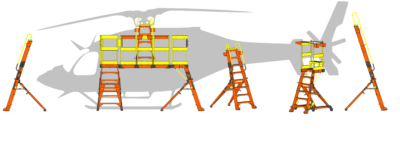The HeliLadder product line is exceptionally stable and is built to the highest quality. It meets or exceeds applicable ANSI and OSHA standards.
ANSI Certification & and OSHA Compliance are two different things! ANSI (American National Standards Institute) sets structural and stability standards for ladder manufacturing, and provides the certification requirements. OSHA (Occupational Safety & Health) however, sets standards for workplace safety: including the proper utilization of ladders.
OSHA requires ladders to be ANSI certified, but more importantly, OSHA requires that ladders are utilized in a safe manner. An ANSI certified ladder is an OSHA violation when used improperly, therefore, many helicopter maintenance tasks are OSHA violations when conventional ladders are used.


Although the ladders pictured here are ANSI certified, the usage of the ladders are OSHA violations. The first photo is an obvious violation (standing on the top rung), but using a taller ladder, as in the second photo, creates a new violation (overreaching) and increases the distance of a fall.
It is the employer’s responsibility to provide proper workstands for the tasks they require their employees to perform. Failure to do so puts technicians at risk of injury, and subjects the employer to OSHA violation fines. In the unfortunate event of a ladder related injury, the employer can be held liable for negligence.


These ANSI certified ladders are OSHA violations when used with helicopters!
Fortunately, the self-evident problems of conventional ladders have finally been resolved with the HeliLadder.
The FAA is acknowledging that OSHA violations can impact flight safety, and is actively evaluating such during safety audits. Flight Safety is dependent upon the workmanship of the aircraft maintenance team. Technicians cannot give full attention to maintenance tasks, if attention is being applied to maintaining their balance, and the likelihood of making an error is increased.
Heliladders are fully ANSI compliant in their design, meeting and exceeding the most recent 14.2 standards issued in 2017. Unlike conventional ladders, they were specifically designed for aircraft maintenance. OSHA compliant in countless applications where other ladders are not.


What sets our aircraft maintenance ladders and workstands apart from traditional ladders?
We encourage you to compare standard HeliLadder brand features with other ground support equipment options.
– Rated as 1AA Special Duty, with a load capacity of 375 lbs. HeliLadders meet and exceed ANSI 14.2 Special Duty requirements.
– The Patented Safety-Lock secures the spreader braces and prevents inadvertent closure of support legs.
– The self-supporting cantilevered design provides unmatched access to the upper aircraft.
– Brace-free support legs straddle passenger steps and crosstubes, providing a wide variety of placement options.
– The broad footprint of the ladder and support provides exceptional stability – well above ANSI requirements.
– By using various extensions, the working height can be quickly changed (We are the only manufacturer to offer this Patent Pending modular system)
– High-Rise Safety Handrails extend 8” above the top rung, allowing for continuous hand access.
– Closed-Loop Safety Handrails terminate at the ladder side rails. There are NO exposed end-caps to snag clothing and gear.
– All steps (top to bottom) are 5” wide to reduce fatigue, and provide enhanced comfort, stability, and security.
– 11” vertical step spacing provides for easier climbing and descending. Conventional ladders are 12”
– Side-rail mounted tool & equipment trays increase maintenance efficiency, reduce the likelihood of FOD damage, and minimize the number of trips up and down the unit.
– Rung-mounted tool and FOD trays can be positioned on either of the top two rungs with quick release snaps.
– Shrouded safety wheels prevent slippage if inadvertently stepped upon while descending.
– High Surface Area Feet (tundra-pads) are available to limit settling in gravel or mud when used on unimproved landing zones.
– Quick visual location of the neon-yellow Safety Handrails is enhanced with the contrasting Safety Orange powdercoating of the stepped unit.
– High Intensity 3M reflective tape on the side rails, tool trays, and supports, provide maximum night visibility on the flightline.


